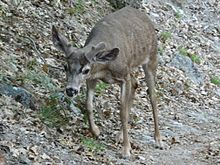California mule deer
| California mule deer | |
|---|---|
 |
|
| A young buck in Yosemite National Park | |
| Scientific classification | |
| Kingdom: | Animalia |
| Phylum: | Chordata |
| Class: | Mammalia |
| Order: | Artiodactyla |
| Family: | Cervidae |
| Subfamily: | Capreolinae |
| Genus: | Odocoileus |
| Species: | O. hemionus |
| Subspecies: | O. h. californicus |
| Trinomial name | |
|
Odocoileus hemionus californicus |
|
The California mule deer (Odocoileus hemionus californicus) is a subspecies of mule deer whose range covers much of the state of California.
One of the principal means of distinguishing the closely related black-tailed deer and white-tailed deer is the growth habit of the buck's antlers. In the case of the California mule deer, the antlers fork in an upward growth, whereas the other species' antlers grow in a forward direction.
This subspecies, O. h. californicus, is widespread throughout northern and central California in the California coastal prairie, as well as inner coastal ranges and interior mountains, especially the Sierra Nevada. This deer is much less frequently found on the floor of the interior valleys, and then mostly frequently in riparian zones.
Generally, the California mule deer has a preference for hill terrain, especially an oak woodland habitat. It is a browser and typically takes over 90% of its diet from shrubs and leaves and the balance from grasses.
California mule deer usually browse close to lakes or streams providing their water. From that water source, they may roam 1-2 mi, and typically make their beds in grassy areas beneath trees within such a one-mile radius from both water and forage.
Repeatedly used beds often are scratched to a nearly level surface, about 2 m in diameter. Less regularly used bedding areas are seen as flattened grass. On hot summer days, California mule deer often seek shade and rest in the midday.
In summer, California mule deer mainly browse on leaves of small trees, shrubs, and herbaceous plants, but also consume many types of berries (including blackberry, huckleberry, salal, and thimbleberry). In winter, they may expand their forage to conifers (particularly twigs of Douglas fir), aspen, willow, dogwood, juniper, and sage. Year-round, they feed on acorns; grasses are a secondary food source. Where humans have encroached on historic deer habitat by suburban development or orchards, California mule deer diversify their diet with garden plant material, tree fruit, and occasionally, pet food.
...
Wikipedia
